RMIT ISYS3312: Hershey's ERP Implementation Failure Case Study
VerifiedAdded on 2022/09/22
|8
|2082
|26
Case Study
AI Summary
This case study examines the failure of Hershey's ERP implementation, focusing on the critical mistakes that led to significant financial losses and operational disruptions. The analysis delves into the integration of systems, the role of ERP in physical and logical integration, and the specific reasons behind Hershey's implementation failure, including scheduling issues, system testing problems, and business process reengineering challenges. The study highlights the importance of proper planning, employee involvement, and experienced consultants in ERP projects. It also discusses the administrative failures, such as the shortened implementation timeline and the timing of the cutover during peak seasons, which exacerbated the negative outcomes. The document provides valuable lessons for organizations undertaking ERP implementations, emphasizing the need for careful consideration of business processes, technological needs, and the expertise of implementation teams. The case study also references relevant literature to support its findings and conclusions.
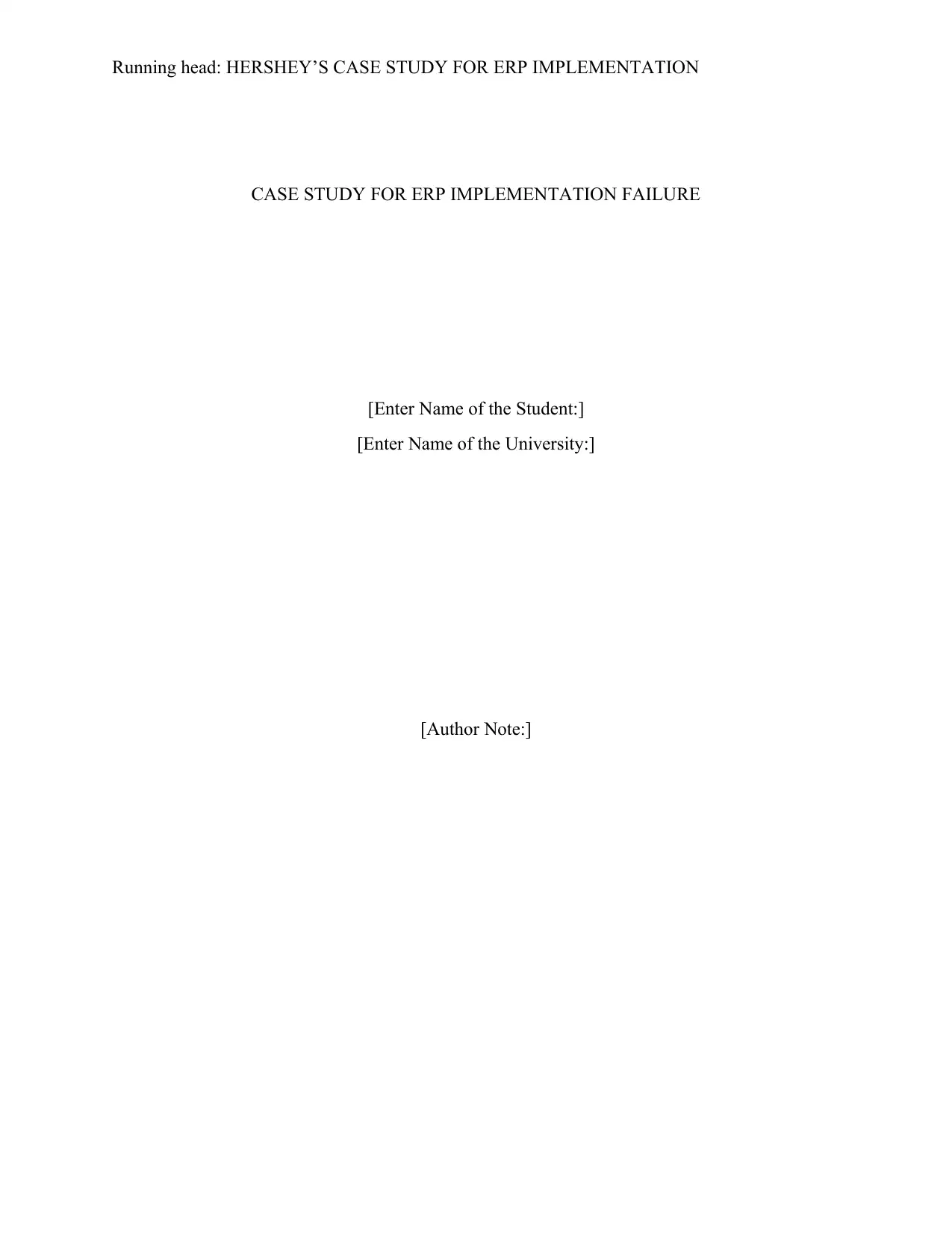
Running head: HERSHEY’S CASE STUDY FOR ERP IMPLEMENTATION
CASE STUDY FOR ERP IMPLEMENTATION FAILURE
[Enter Name of the Student:]
[Enter Name of the University:]
[Author Note:]
CASE STUDY FOR ERP IMPLEMENTATION FAILURE
[Enter Name of the Student:]
[Enter Name of the University:]
[Author Note:]
Paraphrase This Document
Need a fresh take? Get an instant paraphrase of this document with our AI Paraphraser
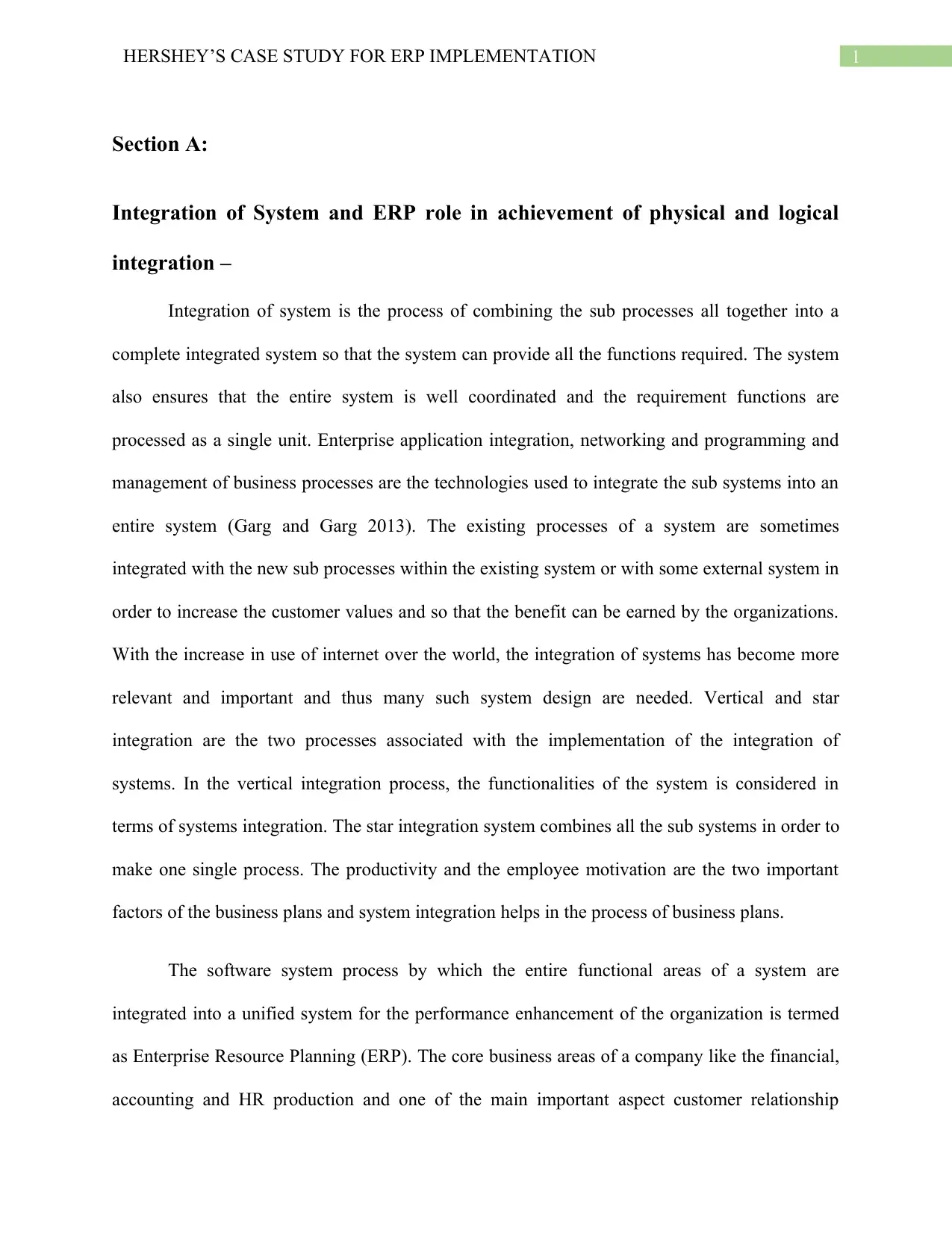
1HERSHEY’S CASE STUDY FOR ERP IMPLEMENTATION
Section A:
Integration of System and ERP role in achievement of physical and logical
integration –
Integration of system is the process of combining the sub processes all together into a
complete integrated system so that the system can provide all the functions required. The system
also ensures that the entire system is well coordinated and the requirement functions are
processed as a single unit. Enterprise application integration, networking and programming and
management of business processes are the technologies used to integrate the sub systems into an
entire system (Garg and Garg 2013). The existing processes of a system are sometimes
integrated with the new sub processes within the existing system or with some external system in
order to increase the customer values and so that the benefit can be earned by the organizations.
With the increase in use of internet over the world, the integration of systems has become more
relevant and important and thus many such system design are needed. Vertical and star
integration are the two processes associated with the implementation of the integration of
systems. In the vertical integration process, the functionalities of the system is considered in
terms of systems integration. The star integration system combines all the sub systems in order to
make one single process. The productivity and the employee motivation are the two important
factors of the business plans and system integration helps in the process of business plans.
The software system process by which the entire functional areas of a system are
integrated into a unified system for the performance enhancement of the organization is termed
as Enterprise Resource Planning (ERP). The core business areas of a company like the financial,
accounting and HR production and one of the main important aspect customer relationship
Section A:
Integration of System and ERP role in achievement of physical and logical
integration –
Integration of system is the process of combining the sub processes all together into a
complete integrated system so that the system can provide all the functions required. The system
also ensures that the entire system is well coordinated and the requirement functions are
processed as a single unit. Enterprise application integration, networking and programming and
management of business processes are the technologies used to integrate the sub systems into an
entire system (Garg and Garg 2013). The existing processes of a system are sometimes
integrated with the new sub processes within the existing system or with some external system in
order to increase the customer values and so that the benefit can be earned by the organizations.
With the increase in use of internet over the world, the integration of systems has become more
relevant and important and thus many such system design are needed. Vertical and star
integration are the two processes associated with the implementation of the integration of
systems. In the vertical integration process, the functionalities of the system is considered in
terms of systems integration. The star integration system combines all the sub systems in order to
make one single process. The productivity and the employee motivation are the two important
factors of the business plans and system integration helps in the process of business plans.
The software system process by which the entire functional areas of a system are
integrated into a unified system for the performance enhancement of the organization is termed
as Enterprise Resource Planning (ERP). The core business areas of a company like the financial,
accounting and HR production and one of the main important aspect customer relationship
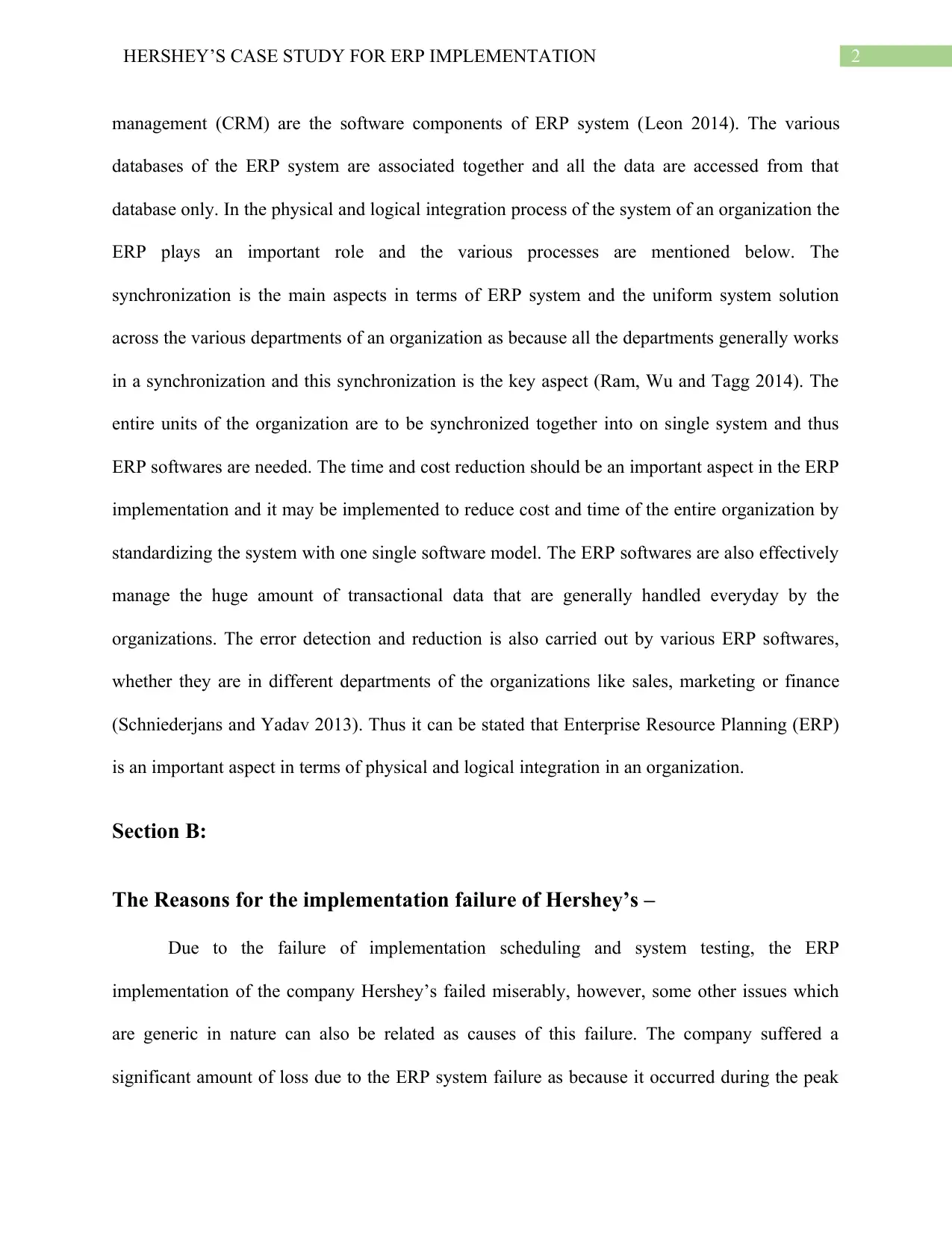
2HERSHEY’S CASE STUDY FOR ERP IMPLEMENTATION
management (CRM) are the software components of ERP system (Leon 2014). The various
databases of the ERP system are associated together and all the data are accessed from that
database only. In the physical and logical integration process of the system of an organization the
ERP plays an important role and the various processes are mentioned below. The
synchronization is the main aspects in terms of ERP system and the uniform system solution
across the various departments of an organization as because all the departments generally works
in a synchronization and this synchronization is the key aspect (Ram, Wu and Tagg 2014). The
entire units of the organization are to be synchronized together into on single system and thus
ERP softwares are needed. The time and cost reduction should be an important aspect in the ERP
implementation and it may be implemented to reduce cost and time of the entire organization by
standardizing the system with one single software model. The ERP softwares are also effectively
manage the huge amount of transactional data that are generally handled everyday by the
organizations. The error detection and reduction is also carried out by various ERP softwares,
whether they are in different departments of the organizations like sales, marketing or finance
(Schniederjans and Yadav 2013). Thus it can be stated that Enterprise Resource Planning (ERP)
is an important aspect in terms of physical and logical integration in an organization.
Section B:
The Reasons for the implementation failure of Hershey’s –
Due to the failure of implementation scheduling and system testing, the ERP
implementation of the company Hershey’s failed miserably, however, some other issues which
are generic in nature can also be related as causes of this failure. The company suffered a
significant amount of loss due to the ERP system failure as because it occurred during the peak
management (CRM) are the software components of ERP system (Leon 2014). The various
databases of the ERP system are associated together and all the data are accessed from that
database only. In the physical and logical integration process of the system of an organization the
ERP plays an important role and the various processes are mentioned below. The
synchronization is the main aspects in terms of ERP system and the uniform system solution
across the various departments of an organization as because all the departments generally works
in a synchronization and this synchronization is the key aspect (Ram, Wu and Tagg 2014). The
entire units of the organization are to be synchronized together into on single system and thus
ERP softwares are needed. The time and cost reduction should be an important aspect in the ERP
implementation and it may be implemented to reduce cost and time of the entire organization by
standardizing the system with one single software model. The ERP softwares are also effectively
manage the huge amount of transactional data that are generally handled everyday by the
organizations. The error detection and reduction is also carried out by various ERP softwares,
whether they are in different departments of the organizations like sales, marketing or finance
(Schniederjans and Yadav 2013). Thus it can be stated that Enterprise Resource Planning (ERP)
is an important aspect in terms of physical and logical integration in an organization.
Section B:
The Reasons for the implementation failure of Hershey’s –
Due to the failure of implementation scheduling and system testing, the ERP
implementation of the company Hershey’s failed miserably, however, some other issues which
are generic in nature can also be related as causes of this failure. The company suffered a
significant amount of loss due to the ERP system failure as because it occurred during the peak
⊘ This is a preview!⊘
Do you want full access?
Subscribe today to unlock all pages.

Trusted by 1+ million students worldwide
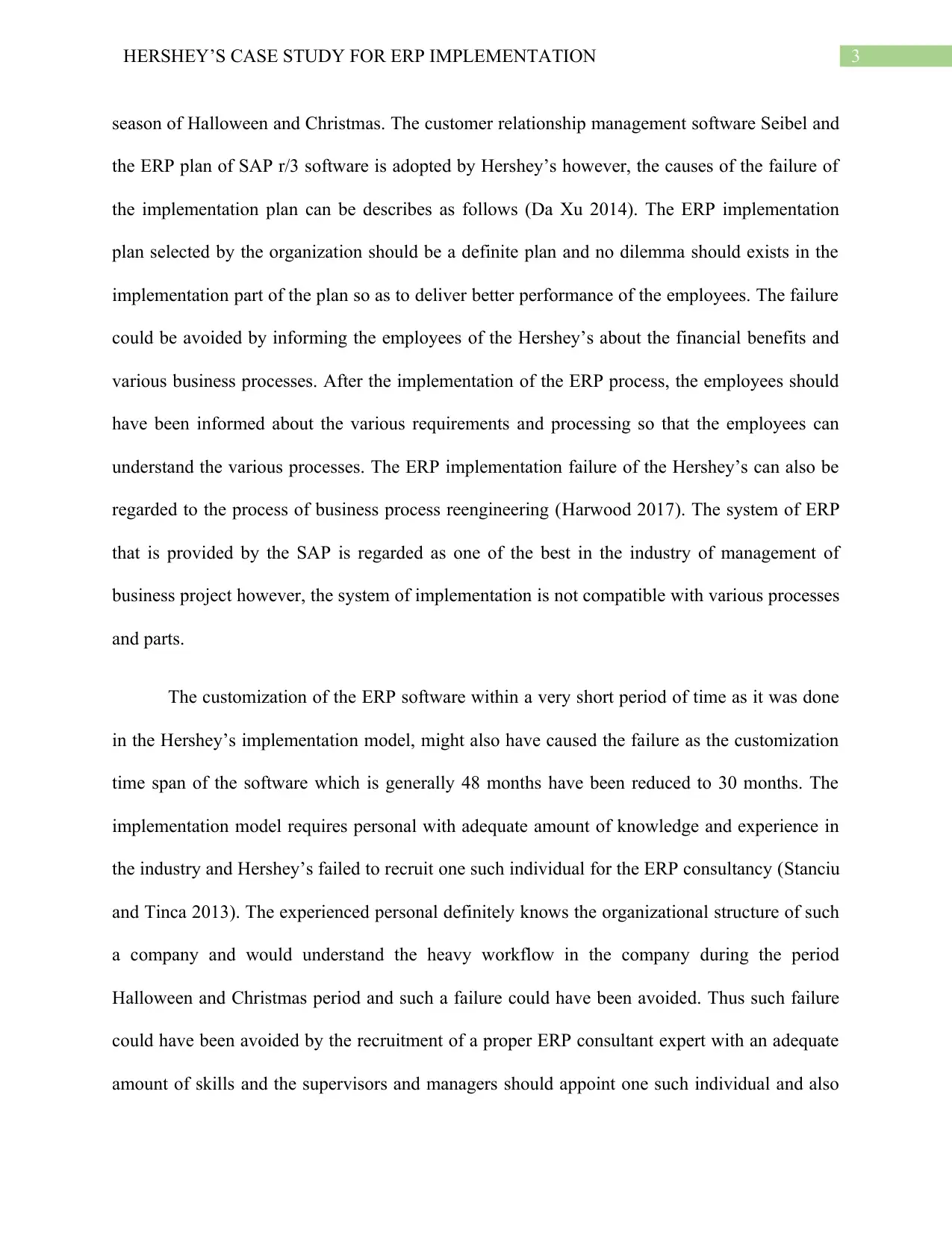
3HERSHEY’S CASE STUDY FOR ERP IMPLEMENTATION
season of Halloween and Christmas. The customer relationship management software Seibel and
the ERP plan of SAP r/3 software is adopted by Hershey’s however, the causes of the failure of
the implementation plan can be describes as follows (Da Xu 2014). The ERP implementation
plan selected by the organization should be a definite plan and no dilemma should exists in the
implementation part of the plan so as to deliver better performance of the employees. The failure
could be avoided by informing the employees of the Hershey’s about the financial benefits and
various business processes. After the implementation of the ERP process, the employees should
have been informed about the various requirements and processing so that the employees can
understand the various processes. The ERP implementation failure of the Hershey’s can also be
regarded to the process of business process reengineering (Harwood 2017). The system of ERP
that is provided by the SAP is regarded as one of the best in the industry of management of
business project however, the system of implementation is not compatible with various processes
and parts.
The customization of the ERP software within a very short period of time as it was done
in the Hershey’s implementation model, might also have caused the failure as the customization
time span of the software which is generally 48 months have been reduced to 30 months. The
implementation model requires personal with adequate amount of knowledge and experience in
the industry and Hershey’s failed to recruit one such individual for the ERP consultancy (Stanciu
and Tinca 2013). The experienced personal definitely knows the organizational structure of such
a company and would understand the heavy workflow in the company during the period
Halloween and Christmas period and such a failure could have been avoided. Thus such failure
could have been avoided by the recruitment of a proper ERP consultant expert with an adequate
amount of skills and the supervisors and managers should appoint one such individual and also
season of Halloween and Christmas. The customer relationship management software Seibel and
the ERP plan of SAP r/3 software is adopted by Hershey’s however, the causes of the failure of
the implementation plan can be describes as follows (Da Xu 2014). The ERP implementation
plan selected by the organization should be a definite plan and no dilemma should exists in the
implementation part of the plan so as to deliver better performance of the employees. The failure
could be avoided by informing the employees of the Hershey’s about the financial benefits and
various business processes. After the implementation of the ERP process, the employees should
have been informed about the various requirements and processing so that the employees can
understand the various processes. The ERP implementation failure of the Hershey’s can also be
regarded to the process of business process reengineering (Harwood 2017). The system of ERP
that is provided by the SAP is regarded as one of the best in the industry of management of
business project however, the system of implementation is not compatible with various processes
and parts.
The customization of the ERP software within a very short period of time as it was done
in the Hershey’s implementation model, might also have caused the failure as the customization
time span of the software which is generally 48 months have been reduced to 30 months. The
implementation model requires personal with adequate amount of knowledge and experience in
the industry and Hershey’s failed to recruit one such individual for the ERP consultancy (Stanciu
and Tinca 2013). The experienced personal definitely knows the organizational structure of such
a company and would understand the heavy workflow in the company during the period
Halloween and Christmas period and such a failure could have been avoided. Thus such failure
could have been avoided by the recruitment of a proper ERP consultant expert with an adequate
amount of skills and the supervisors and managers should appoint one such individual and also
Paraphrase This Document
Need a fresh take? Get an instant paraphrase of this document with our AI Paraphraser
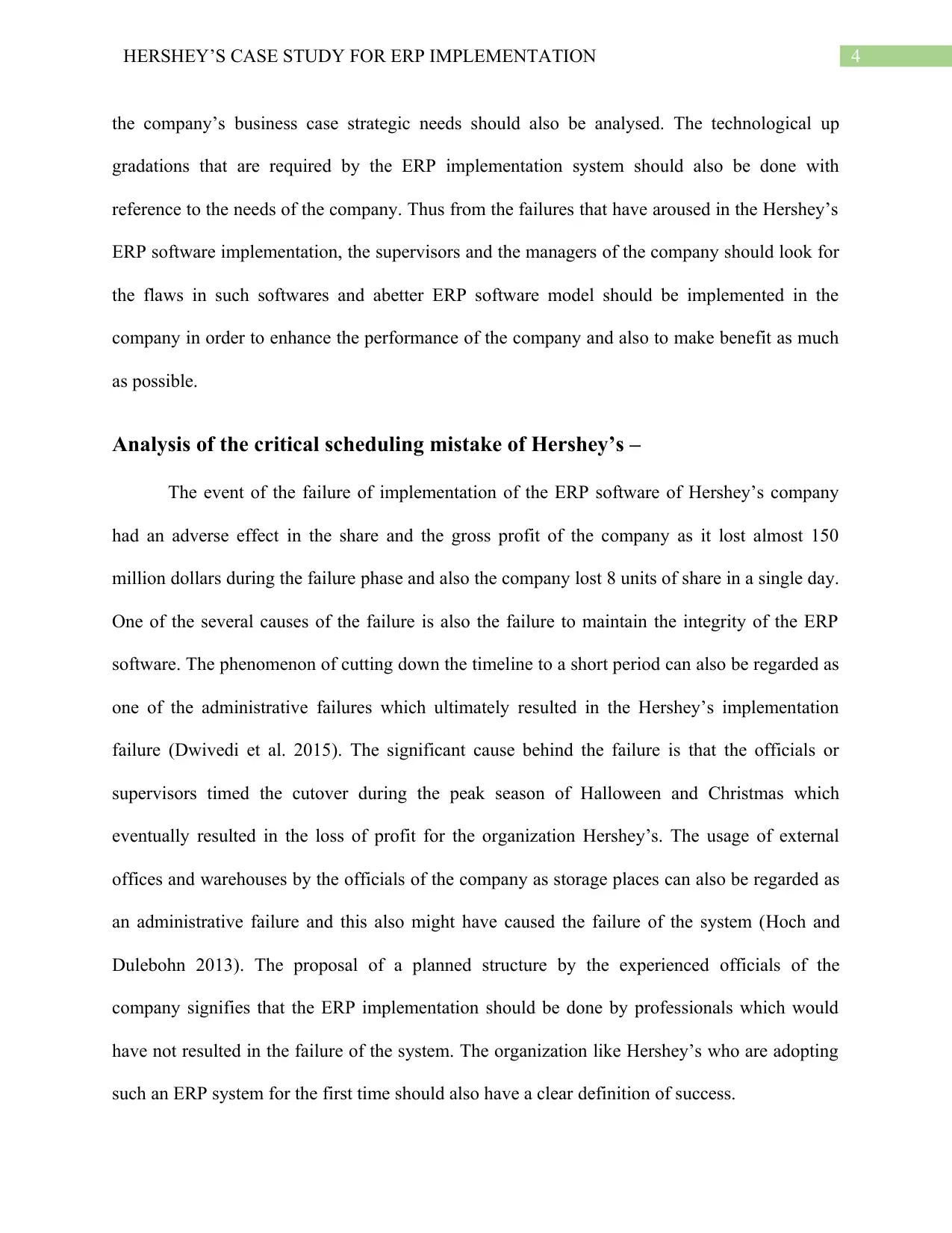
4HERSHEY’S CASE STUDY FOR ERP IMPLEMENTATION
the company’s business case strategic needs should also be analysed. The technological up
gradations that are required by the ERP implementation system should also be done with
reference to the needs of the company. Thus from the failures that have aroused in the Hershey’s
ERP software implementation, the supervisors and the managers of the company should look for
the flaws in such softwares and abetter ERP software model should be implemented in the
company in order to enhance the performance of the company and also to make benefit as much
as possible.
Analysis of the critical scheduling mistake of Hershey’s –
The event of the failure of implementation of the ERP software of Hershey’s company
had an adverse effect in the share and the gross profit of the company as it lost almost 150
million dollars during the failure phase and also the company lost 8 units of share in a single day.
One of the several causes of the failure is also the failure to maintain the integrity of the ERP
software. The phenomenon of cutting down the timeline to a short period can also be regarded as
one of the administrative failures which ultimately resulted in the Hershey’s implementation
failure (Dwivedi et al. 2015). The significant cause behind the failure is that the officials or
supervisors timed the cutover during the peak season of Halloween and Christmas which
eventually resulted in the loss of profit for the organization Hershey’s. The usage of external
offices and warehouses by the officials of the company as storage places can also be regarded as
an administrative failure and this also might have caused the failure of the system (Hoch and
Dulebohn 2013). The proposal of a planned structure by the experienced officials of the
company signifies that the ERP implementation should be done by professionals which would
have not resulted in the failure of the system. The organization like Hershey’s who are adopting
such an ERP system for the first time should also have a clear definition of success.
the company’s business case strategic needs should also be analysed. The technological up
gradations that are required by the ERP implementation system should also be done with
reference to the needs of the company. Thus from the failures that have aroused in the Hershey’s
ERP software implementation, the supervisors and the managers of the company should look for
the flaws in such softwares and abetter ERP software model should be implemented in the
company in order to enhance the performance of the company and also to make benefit as much
as possible.
Analysis of the critical scheduling mistake of Hershey’s –
The event of the failure of implementation of the ERP software of Hershey’s company
had an adverse effect in the share and the gross profit of the company as it lost almost 150
million dollars during the failure phase and also the company lost 8 units of share in a single day.
One of the several causes of the failure is also the failure to maintain the integrity of the ERP
software. The phenomenon of cutting down the timeline to a short period can also be regarded as
one of the administrative failures which ultimately resulted in the Hershey’s implementation
failure (Dwivedi et al. 2015). The significant cause behind the failure is that the officials or
supervisors timed the cutover during the peak season of Halloween and Christmas which
eventually resulted in the loss of profit for the organization Hershey’s. The usage of external
offices and warehouses by the officials of the company as storage places can also be regarded as
an administrative failure and this also might have caused the failure of the system (Hoch and
Dulebohn 2013). The proposal of a planned structure by the experienced officials of the
company signifies that the ERP implementation should be done by professionals which would
have not resulted in the failure of the system. The organization like Hershey’s who are adopting
such an ERP system for the first time should also have a clear definition of success.
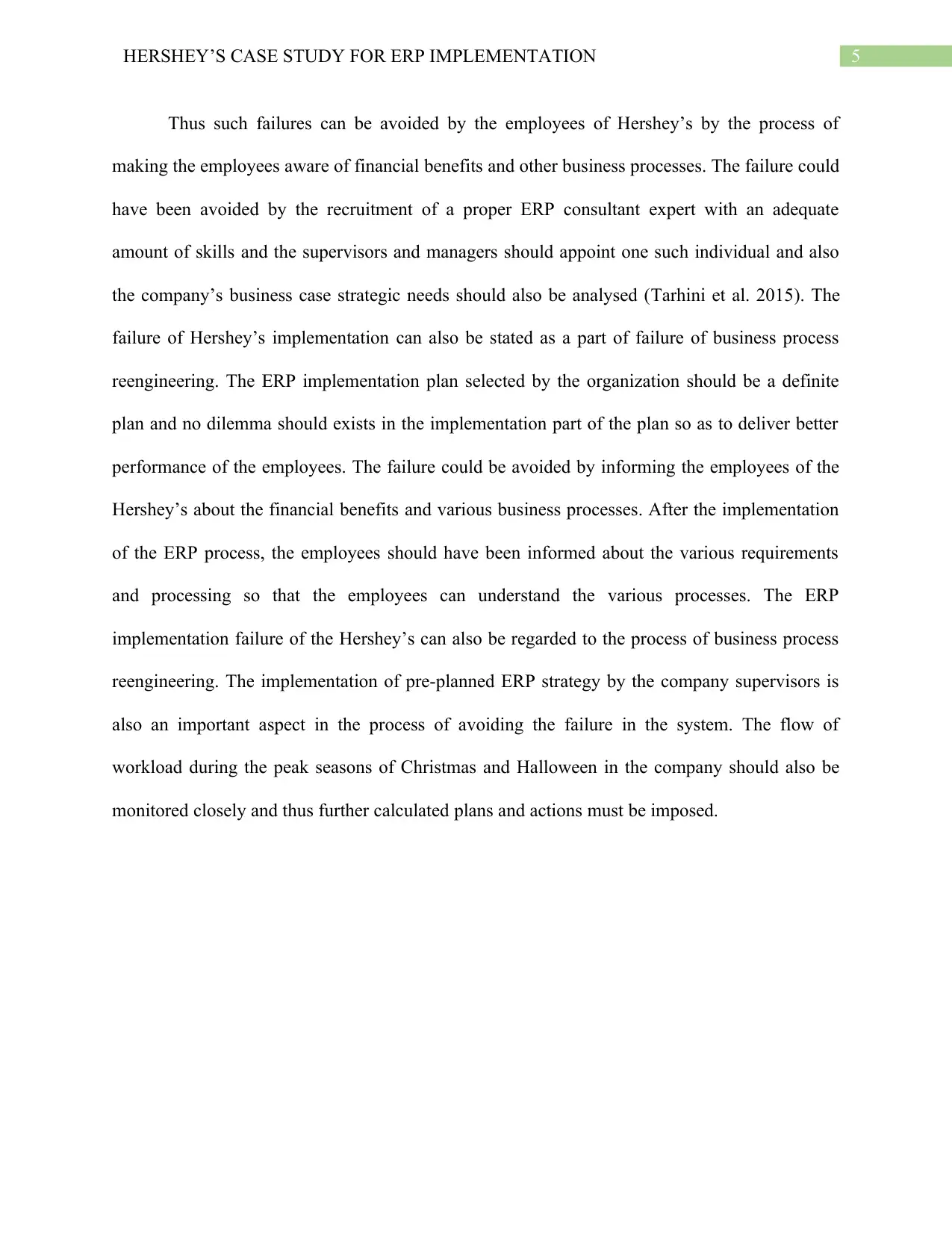
5HERSHEY’S CASE STUDY FOR ERP IMPLEMENTATION
Thus such failures can be avoided by the employees of Hershey’s by the process of
making the employees aware of financial benefits and other business processes. The failure could
have been avoided by the recruitment of a proper ERP consultant expert with an adequate
amount of skills and the supervisors and managers should appoint one such individual and also
the company’s business case strategic needs should also be analysed (Tarhini et al. 2015). The
failure of Hershey’s implementation can also be stated as a part of failure of business process
reengineering. The ERP implementation plan selected by the organization should be a definite
plan and no dilemma should exists in the implementation part of the plan so as to deliver better
performance of the employees. The failure could be avoided by informing the employees of the
Hershey’s about the financial benefits and various business processes. After the implementation
of the ERP process, the employees should have been informed about the various requirements
and processing so that the employees can understand the various processes. The ERP
implementation failure of the Hershey’s can also be regarded to the process of business process
reengineering. The implementation of pre-planned ERP strategy by the company supervisors is
also an important aspect in the process of avoiding the failure in the system. The flow of
workload during the peak seasons of Christmas and Halloween in the company should also be
monitored closely and thus further calculated plans and actions must be imposed.
Thus such failures can be avoided by the employees of Hershey’s by the process of
making the employees aware of financial benefits and other business processes. The failure could
have been avoided by the recruitment of a proper ERP consultant expert with an adequate
amount of skills and the supervisors and managers should appoint one such individual and also
the company’s business case strategic needs should also be analysed (Tarhini et al. 2015). The
failure of Hershey’s implementation can also be stated as a part of failure of business process
reengineering. The ERP implementation plan selected by the organization should be a definite
plan and no dilemma should exists in the implementation part of the plan so as to deliver better
performance of the employees. The failure could be avoided by informing the employees of the
Hershey’s about the financial benefits and various business processes. After the implementation
of the ERP process, the employees should have been informed about the various requirements
and processing so that the employees can understand the various processes. The ERP
implementation failure of the Hershey’s can also be regarded to the process of business process
reengineering. The implementation of pre-planned ERP strategy by the company supervisors is
also an important aspect in the process of avoiding the failure in the system. The flow of
workload during the peak seasons of Christmas and Halloween in the company should also be
monitored closely and thus further calculated plans and actions must be imposed.
⊘ This is a preview!⊘
Do you want full access?
Subscribe today to unlock all pages.

Trusted by 1+ million students worldwide
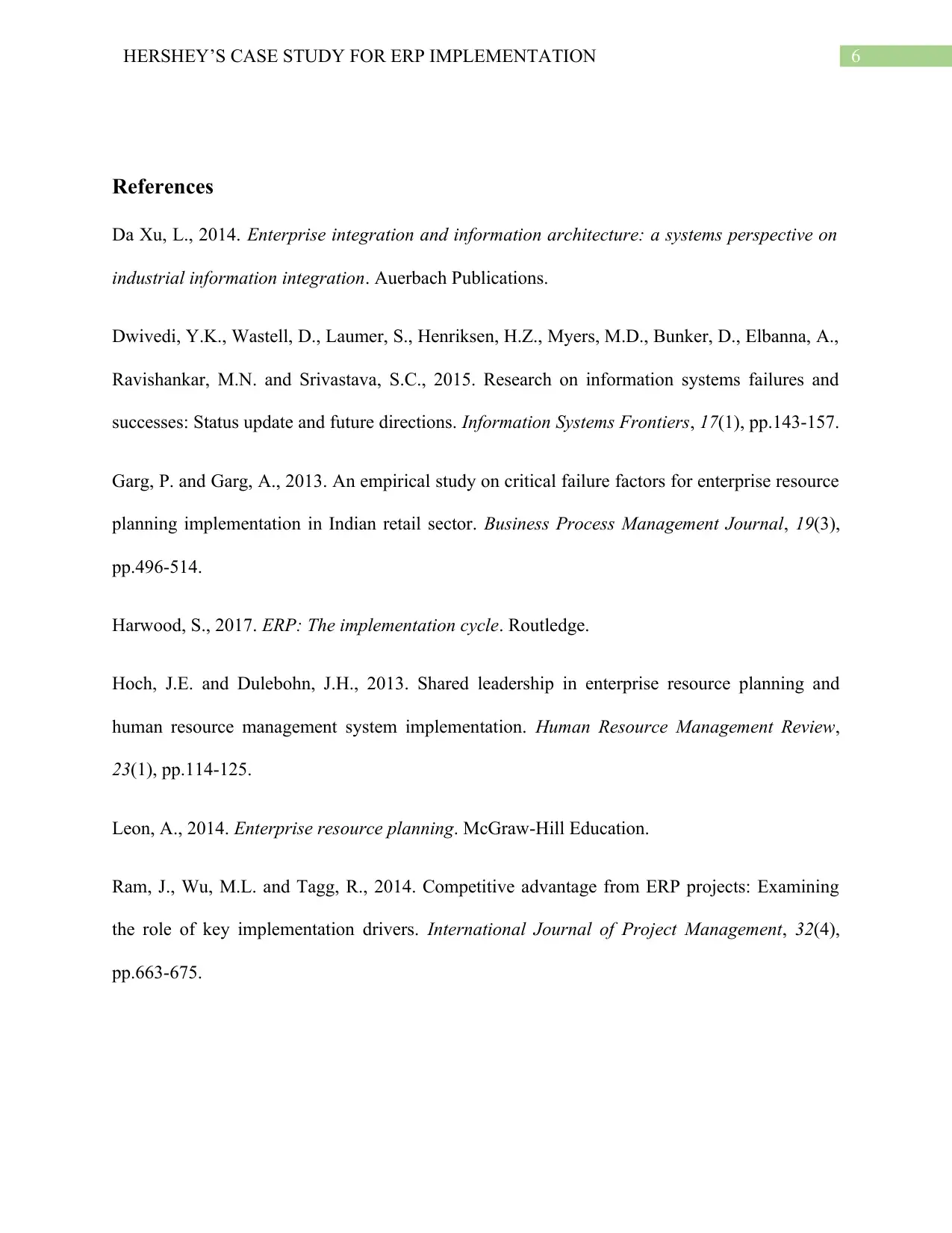
6HERSHEY’S CASE STUDY FOR ERP IMPLEMENTATION
References
Da Xu, L., 2014. Enterprise integration and information architecture: a systems perspective on
industrial information integration. Auerbach Publications.
Dwivedi, Y.K., Wastell, D., Laumer, S., Henriksen, H.Z., Myers, M.D., Bunker, D., Elbanna, A.,
Ravishankar, M.N. and Srivastava, S.C., 2015. Research on information systems failures and
successes: Status update and future directions. Information Systems Frontiers, 17(1), pp.143-157.
Garg, P. and Garg, A., 2013. An empirical study on critical failure factors for enterprise resource
planning implementation in Indian retail sector. Business Process Management Journal, 19(3),
pp.496-514.
Harwood, S., 2017. ERP: The implementation cycle. Routledge.
Hoch, J.E. and Dulebohn, J.H., 2013. Shared leadership in enterprise resource planning and
human resource management system implementation. Human Resource Management Review,
23(1), pp.114-125.
Leon, A., 2014. Enterprise resource planning. McGraw-Hill Education.
Ram, J., Wu, M.L. and Tagg, R., 2014. Competitive advantage from ERP projects: Examining
the role of key implementation drivers. International Journal of Project Management, 32(4),
pp.663-675.
References
Da Xu, L., 2014. Enterprise integration and information architecture: a systems perspective on
industrial information integration. Auerbach Publications.
Dwivedi, Y.K., Wastell, D., Laumer, S., Henriksen, H.Z., Myers, M.D., Bunker, D., Elbanna, A.,
Ravishankar, M.N. and Srivastava, S.C., 2015. Research on information systems failures and
successes: Status update and future directions. Information Systems Frontiers, 17(1), pp.143-157.
Garg, P. and Garg, A., 2013. An empirical study on critical failure factors for enterprise resource
planning implementation in Indian retail sector. Business Process Management Journal, 19(3),
pp.496-514.
Harwood, S., 2017. ERP: The implementation cycle. Routledge.
Hoch, J.E. and Dulebohn, J.H., 2013. Shared leadership in enterprise resource planning and
human resource management system implementation. Human Resource Management Review,
23(1), pp.114-125.
Leon, A., 2014. Enterprise resource planning. McGraw-Hill Education.
Ram, J., Wu, M.L. and Tagg, R., 2014. Competitive advantage from ERP projects: Examining
the role of key implementation drivers. International Journal of Project Management, 32(4),
pp.663-675.
Paraphrase This Document
Need a fresh take? Get an instant paraphrase of this document with our AI Paraphraser
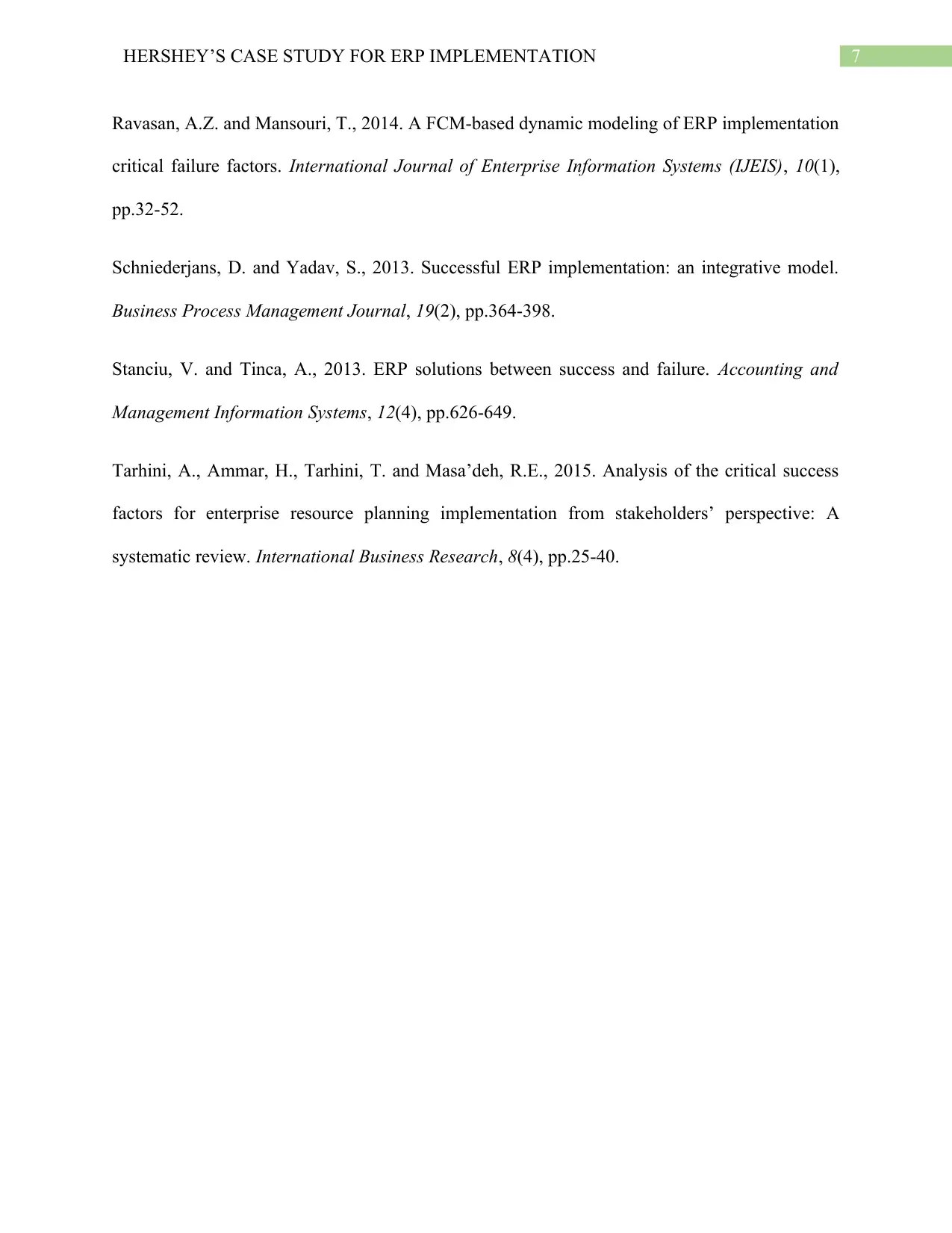
7HERSHEY’S CASE STUDY FOR ERP IMPLEMENTATION
Ravasan, A.Z. and Mansouri, T., 2014. A FCM-based dynamic modeling of ERP implementation
critical failure factors. International Journal of Enterprise Information Systems (IJEIS), 10(1),
pp.32-52.
Schniederjans, D. and Yadav, S., 2013. Successful ERP implementation: an integrative model.
Business Process Management Journal, 19(2), pp.364-398.
Stanciu, V. and Tinca, A., 2013. ERP solutions between success and failure. Accounting and
Management Information Systems, 12(4), pp.626-649.
Tarhini, A., Ammar, H., Tarhini, T. and Masa’deh, R.E., 2015. Analysis of the critical success
factors for enterprise resource planning implementation from stakeholders’ perspective: A
systematic review. International Business Research, 8(4), pp.25-40.
Ravasan, A.Z. and Mansouri, T., 2014. A FCM-based dynamic modeling of ERP implementation
critical failure factors. International Journal of Enterprise Information Systems (IJEIS), 10(1),
pp.32-52.
Schniederjans, D. and Yadav, S., 2013. Successful ERP implementation: an integrative model.
Business Process Management Journal, 19(2), pp.364-398.
Stanciu, V. and Tinca, A., 2013. ERP solutions between success and failure. Accounting and
Management Information Systems, 12(4), pp.626-649.
Tarhini, A., Ammar, H., Tarhini, T. and Masa’deh, R.E., 2015. Analysis of the critical success
factors for enterprise resource planning implementation from stakeholders’ perspective: A
systematic review. International Business Research, 8(4), pp.25-40.
1 out of 8
Related Documents
Your All-in-One AI-Powered Toolkit for Academic Success.
+13062052269
info@desklib.com
Available 24*7 on WhatsApp / Email
![[object Object]](/_next/static/media/star-bottom.7253800d.svg)
Unlock your academic potential
Copyright © 2020–2025 A2Z Services. All Rights Reserved. Developed and managed by ZUCOL.




